Tips For Tomato Seedlings
Most of my seeds are now sown but there are still one or two varieties that didn’t make it to the seed tray or cell – there’s always next season!
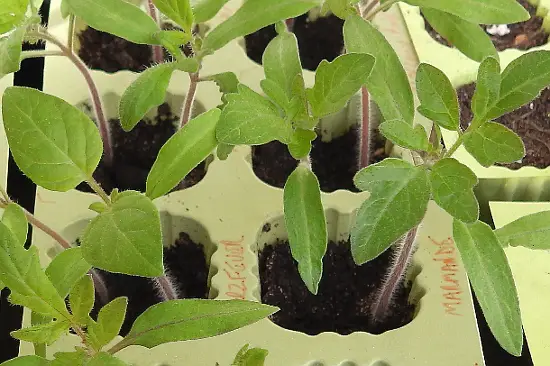
Just in case we have a poor summer, I’m growing about 50% cherry varieties and the rest medium and beefsteak varieties. Cherry toms are the ones most likely to succeed in a poor summer!
Watering Seedlings
Seedlings up to four weeks in compost
At this early stage it is very important not to over water seedlings especially if growing in soil. In fact, they will develop a better root system if they are slightly under watered and have to work hard to search for water.
However, sponges and jiffy’s tend to dry out quickly, owing to the small growing area, so keep an eye on them. It may be best to leave 5mm of water in a tray of sponges before going to work, especially if they are in a sunny position. It’s best not to leave seedlings sat in a tray of water over night – wet during the day and dry (less wet) at night makes a very good wet/dry cycle that will keep the roots healthy.
Seedlings over four weeks
At four or five weeks, it is a good time to transplant seedlings to their own pots. The ones below are Tumbling Toms and are about five to six weeks from sowing. Tumbling Tom tends to remain stocky and are a good choice for hanging baskets and anywhere you would like trailing tomatoes.
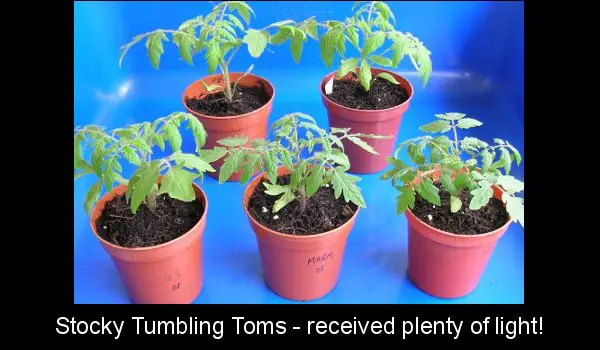
If you add perlite to the mix, you can water from above as there is no chance of compaction and removal of air.
If you are growing in seed compost or potting compost only, it’s a good idea to water from below. It’s also a good idea to allow compost to dry slightly, between waterings, to get plenty of air back into the root zone as the soil dries. Obviously, never allow soil to dry out completely.
Over watering will reduce air in compost, slow plant growth, root development and possibly cause root disease.
Allowing compost to dry-out a little before transplanting helps to make the soil lighter and roots less likely to break.
Feeding is unnecessary
There is enough food in seed and potting compost to feed seedlings. However, if you are growing in sponges or pellets/plugs, you will need to feed your seedlings with First Feed, or 25% to 50% dilution of a general feed such as miracle grow.
Nutrient Strength and Balance
Tomato plants require a very weak mix of nutrients when they are seedlings. As they grow, so their demand for food increases and we feed more often or increase the dose.
However, it’s not just the amount of food they receive but also the mixture or balance of nutrients that is also important.
We often associate blossom end rot with calcium deficiency and large fruiting plants, but small seedlings need calcium too for cell growth and other functions.
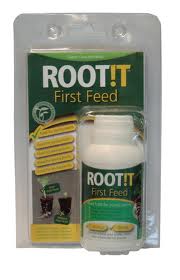
One of the best feeds available for seedlings is “First Feed” and I can recommend it – especially if you are using jiffy pellets or sponges.
It is also excellent as a foliar spray or root boost for soil grown seedlings too because it contains a small amount of just about every nutrient a young tomato plant could wish for. Great if your plants are looking under the weather!
Another boost for healthy seedlings is liquid seaweed extract – ideal as a plant tonic for roots and foliar use.
Rootit First Feed is available here.
Cause of failed germination
Sometimes a whole tray of seedlings will fail to germinate. At this time of the season it is probably because of wide ranging temperatures, and in particular, it’s too cold at night and if the soil is a bit too wet.
Tomato plants grow at their best rate when temperatures don’t fluctuate too much. Keeping the temperature within a specific range (12 to 21C is ideal) but this is almost impossible at this time of year for the home-grower, unless a lot of money is spent of course!
Avoiding leggy seedlings in cloudy weather
- Give them as much light as possible – use reflective white sheeting/paper
- Reduce watering
- Keep temperatures from becoming too high – near radiator etc.
Some varieties are prone to becoming leggy – Red Alert for example. Some trailing and dwarf varities will remain stocky even in low light conditions – Tumbling Tom for example. However, most tall varieties will become leggy without enough light.
Two conditions seedlings hate
- Damp air – especially when it’s cold
- Saturated roots from over watering
Propagators with hoods
If you are using a propagator with hood, open the vents as soon as the seedlings germinate and remove the hood after a couple of days maximum.. This will help to reduce the threat of fungal disease and “Damping-off”. This condition is caused by fungal spores in damp conditions.
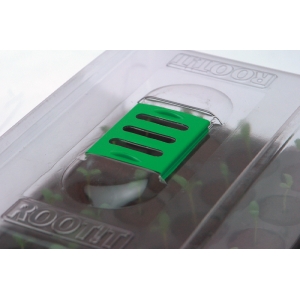
The advantage with using sponges in cell trays is that if we over water, there is still plenty of air in the sponges. If the seedlings are in a warm sunny area during the day, and you are out at work, leaving them in a tray with 5mm of water at the bottom won’t hurt – as long as they are not sat in water over night.
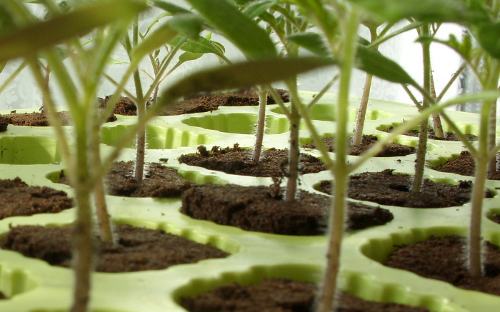
Of course, plants need to be kept indoors at night and won’t be able to be left outside 24/7 until the end of May in the UK (after the last frost).
Buying seedlings
There are some very poor looking seedlings on sale in some garden centres and at Wilco’s too! Always choose the ones with the thickest stems rather than the tallest and ones with dark green rather than light green leaves.
I think we may have some sunny weather this weekend!
Regards,
Nick

David Clarke
I have a number of Ailsa Craig and Moneymaker plants that are now about 10″ high in 4″ pots. They have good root growth,are not leggy and producing site shoots. The question is do I pot on or put straight into their final growing positions in the greenhouse. The greenhouse position gets the sun all day.
Nick
Hi David,
Because there is still a danger of a frosty period over the next few weeks, I would pot them on and keep them indoors at night. You could take a chance, but I would play it safe and plant them in the greenhouse at the end of April beginning of May.
KENNETH HOLMES
Seedlings are doing fine and now have their second set of leaves. Root it first feed given at lunch time and now awaiting the next stage. Will it be Grodan 3″ block or another method. Thanks again for your very interesting newsletter and of course your grow along which every year enjoyable.
Nick
Hi Ken, I’ll do a few different methods so you can choose which one you prefer – do you have rockwool blocks, perlite, coco, clay pellets etc?
Rob
Hi Nick,
Thank you for another fascinating newsletter.
Regarding the use of reflective white sheeting/paper:
Brilliant. So simple, yet so effective.
I have no lopsided or craning seedlings this year.
Cheers!
Nick
Hi Rob,
It’s good to hear your seedlings are doing well – good luck for the season!
Cheers!
Rhys Jaggar
I can heartily recommend RootIt First Feed – I give one dose to 2-3 week old seedlings one week after transplantation and 100% of plants I have treated over the past 3 years (80-100 plants) look fantastic at the 5/6 week potting on stage. It will even recover sickly looking seedlings which did not transplant well into 8cm pots. I am still using my first pot of the stuff and it seems as good as ever.
My Maskotkas had their first outing to the front porch yesterday afternoon – a nice sun trap for four hours in the afternoon.
Today is the first day this season we are expecting 10 hrs solid sunshine. It does not look like continuing, after the BBC got my hopes up yesterday of 3 sunny days in four back to back.
Oh well….
Anonymous
Thanks Nick
Nick
You’re welcome!